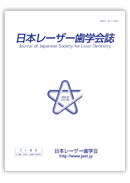20 巻, 3 号
選択された号の論文の13件中1~13を表示しています
- |<
- <
- 1
- >
- >|
学術論文
-
2009 年 20 巻 3 号 p. 120-123
発行日: 2009/12/01
公開日: 2012/04/17
PDF形式でダウンロード (340K) -
2009 年 20 巻 3 号 p. 124-129
発行日: 2009/12/01
公開日: 2012/04/17
PDF形式でダウンロード (571K) -
2009 年 20 巻 3 号 p. 130-134
発行日: 2009/12/01
公開日: 2012/04/17
PDF形式でダウンロード (779K) -
2009 年 20 巻 3 号 p. 135-141
発行日: 2009/12/01
公開日: 2012/04/17
PDF形式でダウンロード (637K) -
2009 年 20 巻 3 号 p. 142-146
発行日: 2009/12/01
公開日: 2012/04/17
PDF形式でダウンロード (564K) -
2009 年 20 巻 3 号 p. 147-149
発行日: 2009/12/01
公開日: 2012/04/17
PDF形式でダウンロード (234K) -
2009 年 20 巻 3 号 p. 150-154
発行日: 2009/12/01
公開日: 2012/04/17
PDF形式でダウンロード (478K) -
2009 年 20 巻 3 号 p. 155-160
発行日: 2009/12/01
公開日: 2012/04/17
PDF形式でダウンロード (924K) -
2009 年 20 巻 3 号 p. 161-164
発行日: 2009/12/01
公開日: 2012/04/17
PDF形式でダウンロード (471K) -
2009 年 20 巻 3 号 p. 165-173
発行日: 2009/12/01
公開日: 2012/04/17
PDF形式でダウンロード (2378K) -
2009 年 20 巻 3 号 p. 174-178
発行日: 2009/12/01
公開日: 2012/04/17
PDF形式でダウンロード (474K) -
2009 年 20 巻 3 号 p. 179-182
発行日: 2009/12/01
公開日: 2012/04/17
PDF形式でダウンロード (403K) -
2009 年 20 巻 3 号 p. 183-187
発行日: 2009/12/01
公開日: 2012/04/17
PDF形式でダウンロード (659K)
- |<
- <
- 1
- >
- >|
